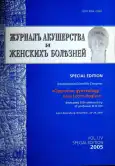Surgical treatment of patients with proximal uterine tubes occlusion
- Authors: Liatoshinskaja P.V.1, Bezhenar V.F.1, Tzhemchizhina T.I.2, Kira Е.F.3
-
Affiliations:
- Military-medical academy
- St.Elisabeth Hospital
- National medical-surgical centre named after N.I. Pirogov of the Ministry of Health of the Russian Federation
- Issue: Vol 54, No 5S (2005)
- Pages: 26-27
- Section: Reviews
- Submitted: 15.11.2005
- Accepted: 06.11.2021
- Published: 15.11.2005
- URL: https://journals.eco-vector.com/jowd/article/view/87198
- DOI: https://doi.org/10.17816/JOWD87198
- ID: 87198
Cite item
Abstract
Introduction. Uterine tubes occlusion at the proximal part is one of the causes of the tubal-peritoneal sterility at women. Frequency of proximal tubal occlusion according to various authors averages about 20%.
Full Text
Introduction. Uterine tubes occlusion at the proximal part is one of the causes of the tubal-peritoneal sterility at women. Frequency of proximal tubal occlusion according to various authors averages about 20%.
Material and methods. With the purpose of recanalization of the proximal part uterine tubes we used a set of coaxial catheters, offered by Novy in 1988 (J- NCS-503570, COOK, USA). We operated 27 patients concerning tubal-peritoneal sterility with uterine tubes occlusion at the intramural part. Average age of the patients was 28,6 ± 5,7 years (from 21 up to 42 years). 9 patients (33,3%) was with primary and 18 (66,7%) - with secondary sterility.
Results. Duration of sterility at the moment of the operation was on the average 4,2 ± 2,03 years. 2 patients with secondary sterility have had labor in past history, 12 - induced abortions, and 4 - extrauterine pregnancy. 4 patients after induced interruption of pregnancy have developed acute endometritis or salpingo-oophoritis. 15 patients (55,6%) have had the Chlamydia infection in past history, 11 (40,7%) - acute adnexitis and 4 (14,8%) - acute endometritis. The condition of the uterine tubes was investigated by hysterosalpingography which helped to determine the fact of their impassability and also to reveal a level of occlusion. According to the examination, 11 patients had bilateral obstruction of intramural part of the uterine tubes, 9 - unilateral, 6 - one tube was impassable at the intramural part while the other was affected by hydrosalpinx, and 1 patient has revealed proximal occlusion of single uterine tube.
As a result of the transcervical recanalization of the intramural occlused uterine tubes the given method allowed us to restore the patency of even one uterine tube at 25 patients (92,6%) during the operation. In total the patency of 31 uterine tubes (81,6%) of 38 recanalized tubes was restored. The laparoscopic control has allowed to find out a pathology of the distal parts of the uterine tubes and peritubal area in 12 patients (57,1%), which were not revealed prior to the operation. 6 patients from this group had hydrosalpinx with a diameter from 1 up to 3 cm, and 9 - adhesive process of small pelvis bodies (1 -II stage - 6, III-IV stage - 3 cases, classification by J.Hulka). At revealing of the given pathological changes we performed salpingo-ovariolysis, fimbriolysis or neosalpingostomy accordingly in each concrete case. During diagnostic hysteroscopy which was carried out before recanalization of the uterine tubes at 7 patients (29,6%) we revealed intrauterine pathology. 4 patients had endometrial polyps, obliterating orifices of uterine tubes that has required hysteroscopic polypectomy; 1 patient had submucous myomatous node with diameter of 1,5 cm in this connection we made its resection; and 3 patients have revealed intrauterine synechiae. One time the transcervical recanalization has become complicated by uterine tube perforation in it isthmic part, that at once was revealed by a parallel laparoscopy. The further movement of catheter has been stopped, and a proceeding bleeding was not observed after its extraction. The postoperative period was normal. Among 25 patients, who had even one uterine tube patent with the help of hysteroscopic transcervical recanalization with laparoscopy control, during postoperative supervision (not less than 6 months) 12 patients became pregnant (48,0%), among them 9 cases - uterine pregnancy, and 3 cases - extrauterine pregnancy in the recanalized tube. Four pregnancies have resulted in term labor, 2 patients are observed at the early gestation and in 3 cases there was a spontaneous abortion at the terms of pregnancy from 6 up to 12 weeks. Frequency of the reocclusion of the operated uterine tubes according to the hysterosalpingography in 1 year after the operation has made 46,2%.
Conclusions. Thus, transcervical recanalization of the uterine tubes is low invasive and effective method of treatment of the tubal occlusion at the intramural part, which helps to restore the patency of uterine tubes in 81,6% of cases. The given method is preferable at patients with possible combined affection of the distal and proximal parts of the uterine tubes and also with intrauterine pathology. Results of research show, that frequency of pregnancy at use of the given technique (48%) is comparable to frequency of pregnancy after microsurgical operations (20-50,8%), and also auxiliary reproductive technologies (19,2-65,4%) which economic expenses are many times higher than the cost of the given surgical method. The adverse factors lowering a reproductive outcome at the transcervical recanalization of the uterine tubes, in our opinion, is a presence of accompanying distal pathology of the uterine tubes, adhesive process in the peritubal area and also one uterine tube.
About the authors
P. V. Liatoshinskaja
Military-medical academy
Email: info@eco-vector.com
кафедра акушерства и гинекологии
Russian Federation, Saint-PetersburgV. F. Bezhenar
Military-medical academy
Email: info@eco-vector.com
Department of obstetrics and gynaecology
Russian Federation, Saint-PetersburgT. I. Tzhemchizhina
St.Elisabeth Hospital
Email: info@eco-vector.com
City’s Center of laparoscopic surgery
Russian Federation, Saint-PetersburgЕ. F. Kira
National medical-surgical centre named after N.I. Pirogov of the Ministry of Health of the Russian Federation
Author for correspondence.
Email: info@eco-vector.com
Russian Federation, Moscow
References
Supplementary files







